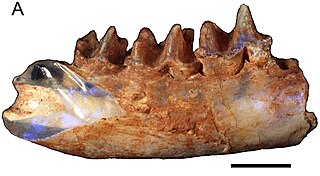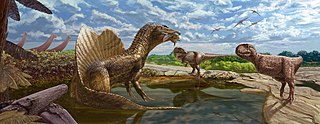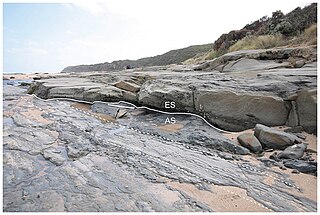
Steropodon is a genus of prehistoric platypus-like monotreme, or egg-laying mammal. It contains a single species, Steropodon galmani, that lived about 100.2–96.6 million years ago (mya) during the Cretaceous period, from early to middle Cenomanian. It is one of the oldest monotremes discovered, and is one of the oldest Australian mammal discoveries. Several other monotremes are known from the Griman Creek Formation, including Dharragarra, Kollikodon, Opalios, Parvopalus, and Stirtodon.

Walgettosuchus is a dubious or possibly invalid genus of extinct tetanuran theropod dinosaur that lived in Australia during the Late Cretaceous (Cenomanian). It is known from a single caudal vertebra.

Rapator is a genus of theropod dinosaur from the Griman Creek Formation of New South Wales, Australia, dating to the Cenomanian age of the Cretaceous period. It contains only the type species, Rapator ornitholestoides, which was originally named by Friedrich von Huene in 1932.

Fulgurotherium is a dubious genus of ornithischian dinosaur from the Late Cretaceous (Cenomanian) Griman Creek Formation. It lived in what is now Australia.

The Cloverly Formation is a geological formation of Early and Late Cretaceous age that is present in parts of Montana, Wyoming, Colorado and Utah in the western United States. It was named for a post office on the eastern side of the Bighorn Basin in Wyoming by N.H. Darton in 1904. The sedimentary rocks of formation were deposited in floodplain environments and contain vertebrate fossils, including a diverse assemblage of dinosaur remains. In 1973, the Cloverly Formation Site was designated as a National Natural Landmark by the National Park Service.

The Bahariya Formation is a fossiliferous geologic formation dating back to the early Cenomanian, which outcrops within the Bahariya depression in Egypt, and is known from oil exploration drilling across much of the Western Desert where it forms an important oil reservoir.
The Echkar Formation is a geological formation comprising sandstones and claystones in the Agadez Region of Niger, central Africa.
The Marree Subgroup, previously described as Maree Formation and Marree Formation, is a geological subgroup in the Eromanga Basin of South Australia whose strata date back to the Aptian. The subgroup was first described as a formation by Forbes in 1966. Dinosaur remains are among the fossils that have been recovered from the formation.

The Wonthaggi Formation is an informal geological formation in Victoria, Australia whose strata date back to the Early Cretaceous. It is part of the Strzelecki Group within the Gippsland Basin. Dinosaur remains are among the fossils that have been recovered from the formation. It is partially equivalent to the Eumeralla Formation.

The Eumeralla Formation is a geological formation in Victoria, Australia whose strata date back to the Early Cretaceous. It is Aptian to Albian in age. Dinosaur remains are among the fossils that have been recovered from the formation, particularly from the Dinosaur Cove locality.
The Kanguk Formation is a geological formation in the Northwest Territories and Nunavut, Canada whose strata date back to the Late Cretaceous. Dinosaur remains are among the fossils that have been recovered from the formation.
The Densuș-Ciula Formation is a geological formation in Romania whose strata date back to the Late Cretaceous. It forms part of the Hațeg Island assemblage. Dinosaur remains are among the fossils that have been recovered from the formation. It is divided up into three members, the lower member is noted for high content of volcanogenic material and is poorly fossiliferous. While the Middle member consists of silty mudstones, sandstones and conglomerates containing volcanogenic clasts and is richly fossiliferous, while the upper member consists of matrix supported red conglomerates and is poorly fossiliferous.
The Itapecuru Formation is a geological formation in Itapecuru Mirim, Maranhão, Brazil.
The Bajo Barreal Formation is a geological formation in the Golfo San Jorge Basin of Chubut and Santa Cruz, Argentina whose strata date back to the Middle Cenomanian to Late Turonian. The formation was first described by Teruggi & Rossetto in 1963. The sandstones, claystones, mudstones, conglomerates and tuff were deposited in a fluvial environment. The upper part of formation is laterally equivalent to the Yacimiento El Trébol and Meseta Espinosa Formation and the lower part to the Laguna Palacios, Cañadón Seco and Comodoro Rivadavia Formations. The Bajo Barreal Formation is a reservoir rock in the Golfo San Jorge Basin.
The Ankazomihaboka Formation is a Coniacian geologic formation in the Mahajanga Basin of northwestern Madagascar. The formation comprises claystones and sandstones deposited in a fluvial to lacustrine environment. The formation is overlain by the Marovoay Beds and overlies basalt.

The Botucatu Formation is an Aptian geologic formation of the Paraná and Pelotas Basins in southern Brazil and northern Uruguay. The formation is composed of quartzitic sandstones, deposited in an eolian environment. Fossil theropod tracks have been reported from the formation.
The Caiuá Formation is an Early Cretaceous geologic formation in Brazil and Paraguay. Fossil theropod tracks have been reported from the formation. The formation, the lowermost unit of the Bauru Group, was deposited in the Barremian and Aptian epochs of the Early Cretaceous, around 130 to 120 Ma. The formation is unconformably overlain by the Santo Anastácio Formation and the unconformity probably represents the start of the opening of the South Atlantic and the formation of the Santos Basin.

Weewarrasaurus is a genus of ornithopod dinosaur from the Late Cretaceous of the Griman Creek Formation near Lightning Ridge, in New South Wales, Australia. The type and only species is W. pobeni, known from the holotype, an isolated dentary preserved in opal, as well as a secondary referred dentary. It is thought to have co-existed with multiple other ornithopods of different sizes and lineages.

Fostoria is a genus of iguanodontian ornithopod dinosaur from the Griman Creek Formation of New South Wales, Australia. The type and only species, Fostoria dhimbangunmal was described in 2019.
Parvopalus is an extinct genus of monotreme mammal from the Late Cretaceous (Cenomanian) Griman Creek Formation of Australia. The genus contains a single species, P. clytiei, known from a partial left dentary. Several other monotremes are known from the Griman Creek Formation, including Opalios and Dharragarra—which were described in the same publication as Parvopalus—as well as Kollikodon, Steropodon, and Stirtodon.

















